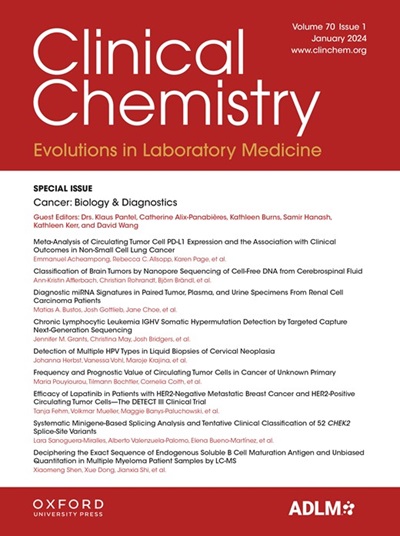通过捕捉癌症相关分子特征的尿液 cfDNA 片段热点进行基于机器学习的膀胱癌检测
IF 7.1
2区 医学
Q1 MEDICAL LABORATORY TECHNOLOGY
引用次数: 0
摘要
背景 基于 cfDNA 片段组学的液体活检是一种潜在的无创膀胱癌 (BLCA) 检测方法,但其临床需求仍未得到满足。方法 我们在一组 55 名膀胱癌患者、51 名良性疾病患者和 11 名健康志愿者中评估了 cfDNA 热点驱动的机器学习模型的诊断性能。我们还进一步进行了功能生物信息学分析,以了解生物学原理并解释该工具的诊断能力。结果 基于尿液 cfDNA 热点的机器学习模型实现了有效的 BLCA 检测,达到了较高的性能(曲线下面积 0.96)和 87% 的灵敏度以及 100% 的特异性。该模型的表现优于使用其他 cfDNA 衍生特征的模型。在分期分析中,基于尿液热点的模型对早期(低级别 Ta 和 T1)和晚期(高级别 T1 和肌肉浸润性)疾病的敏感性分别为 71% 和 92%,特异性为 100% 。从生物学角度来看,cfDNA 热点能有效检索调控元素,并与原发细胞相关。尿液 cfDNA 热点特异性地捕捉到了与 BLCA 相关的分子特征,包括关键功能通路、全基因组关联研究中发现的与 BLCA 风险相关的染色体位点,或在 BLCA 肿瘤中出现频繁体细胞改变的染色体位点,以及转录因子调控图谱。结论 我们的研究结果支持将尿液 cfDNA 片段热点应用于无创 BLCA 诊断,以及未来有关其分子病理学和异质性的转化研究。本文章由计算机程序翻译,如有差异,请以英文原文为准。
Machine Learning-Based Detection of Bladder Cancer by Urine cfDNA Fragmentation Hotspots that Capture Cancer-Associated Molecular Features
Background cfDNA fragmentomics-based liquid biopsy is a potential option for noninvasive bladder cancer (BLCA) detection that remains an unmet clinical need. Methods We assessed the diagnostic performance of cfDNA hotspot-driven machine-learning models in a cohort of 55 BLCA patients, 51 subjects with benign conditions, and 11 healthy volunteers. We further performed functional bioinformatics analysis for biological understanding and interpretation of the tool’s diagnostic capability. Results Urinary cfDNA hotspots-based machine-learning model enabled effective BLCA detection, achieving high performance (area under curve 0.96) and an 87% sensitivity at 100% specificity. It outperformed models using other cfDNA-derived features. In stage-stratified analysis, the sensitivity at 100% specificity of the urine hotspots-based model was 71% and 92% for early (low-grade Ta and T1) and advanced (high-grade T1 and muscle-invasive) disease, respectively. Biologically, cfDNA hotspots effectively retrieved regulatory elements and were correlated with the cell of origin. Urine cfDNA hotspots specifically captured BLCA-related molecular features, including key functional pathways, chromosome loci associated with BLCA risk as identified in genome-wide association studies, or presenting frequent somatic alterations in BLCA tumors, and the transcription factor regulatory landscape. Conclusions Our findings support the applicability of urine cfDNA fragmentation hotspots for noninvasive BLCA diagnosis, as well as for future translational study regarding its molecular pathology and heterogeneity.
求助全文
通过发布文献求助,成功后即可免费获取论文全文。
去求助
来源期刊

Clinical chemistry
医学-医学实验技术
CiteScore
11.30
自引率
4.30%
发文量
212
审稿时长
1.7 months
期刊介绍:
Clinical Chemistry is a peer-reviewed scientific journal that is the premier publication for the science and practice of clinical laboratory medicine. It was established in 1955 and is associated with the Association for Diagnostics & Laboratory Medicine (ADLM).
The journal focuses on laboratory diagnosis and management of patients, and has expanded to include other clinical laboratory disciplines such as genomics, hematology, microbiology, and toxicology. It also publishes articles relevant to clinical specialties including cardiology, endocrinology, gastroenterology, genetics, immunology, infectious diseases, maternal-fetal medicine, neurology, nutrition, oncology, and pediatrics.
In addition to original research, editorials, and reviews, Clinical Chemistry features recurring sections such as clinical case studies, perspectives, podcasts, and Q&A articles. It has the highest impact factor among journals of clinical chemistry, laboratory medicine, pathology, analytical chemistry, transfusion medicine, and clinical microbiology.
The journal is indexed in databases such as MEDLINE and Web of Science.
 求助内容:
求助内容: 应助结果提醒方式:
应助结果提醒方式:


